A Semi-Automatic-Based Approach to the Extraction of Underwater Archaeological Features from Ultra-High-Resolution Bathymetric Data: The Case of the Submerged Baia Archaeological Park
Abstract
1. Introduction
2. Materials and Methods
2.1. Bathymetric Data Acquisitions and Processing
2.2. Post-Processing and Enhancement of UHR MBES Data
2.3. Processing Point Cloud Data
2.3.1. Hillshade (HS), Hill Shading from Multiple Directions (MHS), and PCA of Hill Shading
2.3.2. Slope Gradient
2.3.3. Simple Local Relief Model
2.3.4. Sky View Factor (SVF)
2.3.5. Openness
2.3.6. Local Dominance
2.4. The Modified Automatic Feature Extraction Approach (MAFE)
3. Results and Discussion
4. Conclusions
Author Contributions
Funding
Data Availability Statement
Acknowledgments
Conflicts of Interest
References
- Otero, J. Heritage Conservation Future: Where We Stand, Challenges Ahead, and a Paradigm Shift. Glob. Chall. 2022, 6, 2100084. [Google Scholar] [CrossRef] [PubMed]
- Vu Hoang, K. The Benefits of Preserving and Promoting Cultural Heritage Values for the Sustainable Development of the Country. E3S Web Conf. 2021, 234, 00076. [Google Scholar] [CrossRef]
- Agapiou, A.; Lysandrou, V.; Hadjimitsis, D.G. Earth Observation Contribution to Cultural Heritage Disaster Risk Management: Case Study of Eastern Mediterranean Open Air Archaeological Monuments and Sites. Remote Sens. 2020, 12, 1330. [Google Scholar] [CrossRef]
- Agapiou, A.; Lysandrou, V.; Alexakis, D.D.; Themistocleous, K.; Cuca, B.; Argyriou, A.; Sarris, A.; Hadjimitsis, D.G. Cultural Heritage Management and Monitoring Using Remote Sensing Data and GIS: The Case Study of Paphos Area, Cyprus. Comput. Environ. Urban Syst. 2015, 54, 230–239. [Google Scholar] [CrossRef]
- Demetrescu, E.; Ferdani, D. From Field Archaeology to Virtual Reconstruction: A Five Steps Method Using the Extended Matrix. Appl. Sci. 2021, 11, 5206. [Google Scholar] [CrossRef]
- Moscato, V. Big Data in Cultural Heritage. In Encyclopedia of Big Data Technologies; Sakr, S., Zomaya, A., Eds.; Springer International Publishing: Cham, Switzerland, 2018; pp. 1–6. ISBN 978-3-319-63962-8. [Google Scholar]
- Poulopoulos, V.; Wallace, M. Digital Technologies and the Role of Data in Cultural Heritage: The Past, the Present, and the Future. Big Data Cogn. Comput. 2022, 6, 73. [Google Scholar] [CrossRef]
- Aznar, M.J. In Situ Preservation of Underwater Cultural Heritage as an International Legal Principle. J. Marit. Archaeol. 2018, 13, 67–81. [Google Scholar] [CrossRef]
- Prott, L. Underwater Cultural Heritage at Risk: Managing Natural and Human Impacts: REVIEWS. Int. J. Naut. Archaeol. 2007, 36, 429–431. [Google Scholar] [CrossRef]
- Pearson, N. Protecting and Preserving Underwater Cultural Heritage in Southeast Asia. In The Palgrave Handbook on Art Crime; Hufnagel, S., Chappell, D., Eds.; Palgrave Macmillan: London, UK, 2019; pp. 685–730. ISBN 978-1-137-54405-6. [Google Scholar]
- Secci, M. Survey and Recording Technologies in Italian Underwater Cultural Heritage: Research and Public Access within the Framework of the 2001 UNESCO Convention. J. Marit. Archaeol. 2017, 12, 109–123. [Google Scholar] [CrossRef]
- Trakadas, A.; Karra, A. Coastal Landscapes, Environmental Change, and Maritime Cultural Heritage Resources in Morocco: The Case Study of Essaouira. J. Marit. Archaeol. 2022, 17, 401–420. [Google Scholar] [CrossRef]
- Bruno, F.; Barbieri, L.; Muzzupappa, M.; Tusa, S.; Fresina, A.; Oliveri, F.; Lagudi, A.; Cozza, A.; Peluso, R. Enhancing Learning and Access to Underwater Cultural Heritage through Digital Technologies: The Case Study of the “Cala Minnola” Shipwreck Site. Digit. Appl. Archaeol. Cult. Herit. 2019, 13, e00103. [Google Scholar] [CrossRef]
- Scalercio, E.; Sangiovanni, F.; Gallo, A.; Barbieri, L. Underwater Power Tools for In Situ Preservation, Cleaning and Consolidation of Submerged Archaeological Remains. J. Mar. Sci. Eng. 2021, 9, 676. [Google Scholar] [CrossRef]
- Maarleveld, T.J.; Guérin, U.; Egger, B. Manual for Activities Directed at Underwater Cultural Heritage: Guidelines to the Annex of the UNESCO 2001 Convention; UNESCO: Paris, France, 2013; ISBN 978-92-3-001122-2. [Google Scholar]
- Tusa, S. Il Mare delle Egadi: Itinerari e Parchi Archeologici Subacquei; Regione Siciliana, Assessorato dei Beni Culturali e Ambientali e della Pubblica Istruzione, Dipartimento dei Beni Culturali e Ambientali e Dell’educazione Permanente: Palermo, Italy, 2005; ISBN 978-88-88559-22-3. [Google Scholar]
- Agizza, S. A Project Proposal for the Construction of Underwater Archaeological Nature Routes into the Protected Marine Area of Santa Maria Di Castellabate. Int. J. Environ. Geoinformatics 2015, 2, 49–55. [Google Scholar] [CrossRef]
- Papatheodorou, G.; Geraga, M.; Chalari, A.; Christodoulou, D.; Iatrou, M.; Fakiris, E.; Prevenios, M.; Ferentinos, G. Remote Sensing for Underwater Archaeology: Case Stud-Ies from Greece and Eastern Mediterranean. Bull. Geol. Soc. Greece 2017, 44, 100. [Google Scholar] [CrossRef]
- Luo, L.; Wang, X.; Guo, H.; Lasaponara, R.; Zong, X.; Masini, N.; Wang, G.; Shi, P.; Khatteli, H.; Chen, F.; et al. Airborne and Spaceborne Remote Sensing for Archaeological and Cultural Heritage Applications: A Review of the Century (1907–2017). Remote Sens. Environ. 2019, 232, 111280. [Google Scholar] [CrossRef]
- Westley, K. Satellite-Derived Bathymetry for Maritime Archaeology: Testing Its Effectiveness at Two Ancient Harbours in the Eastern Mediterranean. J. Archaeol. Sci. Rep. 2021, 38, 103030. [Google Scholar] [CrossRef]
- Deroin, J.-P.; Bou Kheir, R.; Abdallah, C. Geoarchaeological Remote Sensing Survey for Cultural Heritage Management. Case Study from Byblos (Jbail, Lebanon). J. Cult. Herit. 2017, 23, 37–43. [Google Scholar] [CrossRef]
- Cuca, B.; Hadjimitsis, D.G. Space Technology Meets Policy: An Overview of Earth Observation Sensors for Monitoring of Cultural Landscapes within Policy Framework for Cultural Heritage. J. Archaeol. Sci. Rep. 2017, 14, 727–733. [Google Scholar] [CrossRef]
- Casal, G.; Monteys, X.; Hedley, J.; Harris, P.; Cahalane, C.; McCarthy, T. Assessment of Empirical Algorithms for Bathymetry Extraction Using Sentinel-2 Data. Int. J. Remote Sens. 2019, 40, 2855–2879. [Google Scholar] [CrossRef]
- Cahalane, C.; Magee, A.; Monteys, X.; Casal, G.; Hanafin, J.; Harris, P. A Comparison of Landsat 8, RapidEye and Pleiades Products for Improving Empirical Predictions of Satellite-Derived Bathymetry. Remote Sens. Environ. 2019, 233, 111414. [Google Scholar] [CrossRef]
- McCarthy, J.; Benjamin, J. Multi-Image Photogrammetry for Underwater Archaeological Site Recording: An Accessible, Diver-Based Approach. J. Marit. Archaeol. 2014, 9, 95–114. [Google Scholar] [CrossRef]
- Drap, P. Underwater Photogrammetry for Archaeology. In Special Applications of Photogrammetry; Da Silva, D.C., Ed.; InTech: Nappanee, IN, USA, 2012; ISBN 978-953-51-0548-0. [Google Scholar]
- Semaan, L.; Salama, M.S. Underwater Photogrammetric Recording at the Site of Anfeh, Lebanon. In 3D Recording and Interpretation for Maritime Archaeology; McCarthy, J.K., Benjamin, J., Winton, T., van Duivenvoorde, W., Eds.; Springer International Publishing: Cham, Switzerland, 2019; pp. 67–87. ISBN 978-3-030-03635-5. [Google Scholar]
- Wright, A.E.; Conlin, D.L.; Shope, S.M. Assessing the Accuracy of Underwater Photogrammetry for Archaeology: A Comparison of Structure from Motion Photogrammetry and Real Time Kinematic Survey at the East Key Construction Wreck. J. Mar. Sci. Eng. 2020, 8, 849. [Google Scholar] [CrossRef]
- Ødegård, Ø.; Hansen, R.E.; Singh, H.; Maarleveld, T.J. Archaeological Use of Synthetic Aperture Sonar on Deepwater Wreck Sites in Skagerrak. J. Archaeol. Sci. 2018, 89, 1–13. [Google Scholar] [CrossRef]
- Janowski, L.; Kubacka, M.; Pydyn, A.; Popek, M.; Gajewski, L. From Acoustics to Underwater Archaeology: Deep Investigation of a Shallow Lake Using High-Resolution Hydroacoustics—The Case of Lake Lednica, Poland. Archaeometry 2021, 63, 1059–1080. [Google Scholar] [CrossRef]
- Menna, F.; Agrafiotis, P.; Georgopoulos, A. State of the Art and Applications in Archaeological Underwater 3D Recording and Mapping. J. Cult. Herit. 2018, 33, 231–248. [Google Scholar] [CrossRef]
- De Smet, T.S. Emerging Remote Sensing Methods in Underwater Archaeology. In New Directions in the Search for the First Floridians; University Press of Florida: Gainesville, FL, USA, 2019; pp. 221–240. ISBN 978-1-68340-073-8. [Google Scholar]
- Quinn, R. Acoustic Remote Sensing in Maritime Archaeology; Oxford University Press: Oxford, UK, 2011. [Google Scholar]
- Plets, R.; Quinn, R.; Forsythe, W.; Westley, K.; Bell, T.; Benetti, S.; McGrath, F.; Robinson, R. Using Multibeam Echo-Sounder Data to Identify Shipwreck Sites: Archaeological Assessment of the Joint Irish Bathymetric Survey Data: Using Multibeam Echo-Sounder Data to Identify Shipwreck Sites. Int. J. Naut. Archaeol. 2011, 40, 87–98. [Google Scholar] [CrossRef]
- Ødegård, Ø.; Sørensen, A.J.; Hansen, R.E.; Ludvigsen, M. A New Method for Underwater Archaeological Surveying Using Sensors and Unmanned Platforms. IFAC-Pap. 2016, 49, 486–493. [Google Scholar] [CrossRef]
- McCarthy, J.; Benjamin, J.; Winton, T.; van Duivenvoorde, W. The Rise of 3D in Maritime Archaeology. In 3D Recording and Interpretation for Maritime Archaeology; McCarthy, J.K., Benjamin, J., Winton, T., van Duivenvoorde, W., Eds.; Springer International Publishing: Cham, Switzerland, 2019; pp. 1–10. ISBN 978-3-030-03635-5. [Google Scholar]
- Bates, C.R.; Lawrence, M.; Dean, M.; Robertson, P. Geophysical Methods for Wreck-Site Monitoring: The Rapid Archaeological Site Surveying and Evaluation (RASSE) Programme: Evaluating Geophysical Methods for Wreck-Site Monitoring. Int. J. Naut. Archaeol. 2011, 40, 404–416. [Google Scholar] [CrossRef]
- Grządziel, A. Using Remote Sensing Data to Identify Large Bottom Objects: The Case of World War II Shipwreck of General von Steuben. Geosciences 2020, 10, 240. [Google Scholar] [CrossRef]
- Violante, C. Acoustic Remote Sensing for Seabed Archaeology. In Proceedings of the IMEKO TC4 International Conference on Metrology for Archaeology and Cultural Heritage, Trento, Italy, 22–24 October 2020; pp. 21–26. [Google Scholar]
- Gkionis, P.; Papatheodorou, G.; Geraga, M. The Benefits of 3D and 4D Synthesis of Marine Geophysical Datasets for Analysis and Visualisation of Shipwrecks, and for Interpretation of Physical Processes over Shipwreck Sites: A Case Study off Methoni, Greece. J. Mar. Sci. Eng. 2021, 9, 1255. [Google Scholar] [CrossRef]
- Papadopoulos, N. Shallow Offshore Geophysical Prospection of Archaeological Sites in Eastern Mediterranean. Remote Sens. 2021, 13, 1237. [Google Scholar] [CrossRef]
- Simyrdanis, K.; Papadopoulos, N.; Kim, J.; Tsourlos, P.; Moffat, I. Archaeological Investigations in the Shallow Seawater Environment with Electrical Resistivity Tomography. Surf. Geophys. 2015, 13, 601–611. [Google Scholar] [CrossRef]
- Nayak, N.; Nara, M.; Gambin, T.; Wood, Z.; Clark, C.M. Machine Learning Techniques for AUV Side-Scan Sonar Data Feature Extraction as Applied to Intelligent Search for Underwater Archaeological Sites. In Proceedings of the Field and Service Robotics, Zurich, Switzerland, 12–15 September 2017; Ishigami, G., Yoshida, K., Eds.; Springer: Singapore, 2021; pp. 219–233. [Google Scholar]
- Missiaen, T.; Sakellariou, D.; Flemming, N.C. Survey Strategies and Techniques in Underwater Geoarchaeological Research: An Overview with Emphasis on Prehistoric Sites. In Under the Sea: Archaeology and Palaeolandscapes of the Continental Shelf; Bailey, G.N., Harff, J., Sakellariou, D., Eds.; Springer International Publishing: Cham, Switzerland, 2017; pp. 21–37. ISBN 978-3-319-53160-1. [Google Scholar]
- Chang, R.; Wang, Y.; Hou, J.; Qiu, S.; Nian, R.; He, B.; Lendasse, A. Underwater Object Detection with Efficient Shadow-Removal for Side Scan Sonar Images. In Proceedings of the OCEANS 2016, Shanghai, China, 10–13 April 2016; pp. 1–5. [Google Scholar]
- Drap, P.; Papini, O.; Merad, D.; Pasquet, J.; Royer, J.-P.; Motasem Nawaf, M.; Saccone, M.; Ben Ellefi, M.; Chemisky, B.; Seinturier, J.; et al. Deepwater Archaeological Survey: An Interdisciplinary and Complex Process. In 3D Recording and Interpretation for Maritime Archaeology; McCarthy, J.K., Benjamin, J., Winton, T., van Duivenvoorde, W., Eds.; Springer International Publishing: Cham, Switzerland, 2019; pp. 135–153. ISBN 978-3-030-03635-5. [Google Scholar]
- Masini, N.; Abate, N.; Gizzi, F.T.; Vitale, V.; Minervino Amodio, A.; Sileo, M.; Biscione, M.; Lasaponara, R.; Bentivenga, M.; Cavalcante, F. UAV LiDAR Based Approach for the Detection and Interpretation of Archaeological Micro Topography under Canopy—The Rediscovery of Perticara (Basilicata, Italy). Remote Sens. 2022, 14, 6074. [Google Scholar] [CrossRef]
- Štular, B.; Eichert, S.; Lozić, E. Airborne LiDAR Point Cloud Processing for Archaeology. Pipeline and QGIS Toolbox. Remote Sens. 2021, 13, 3225. [Google Scholar] [CrossRef]
- Evans, D.H.; Fletcher, R.J.; Pottier, C.; Chevance, J.-B.; Soutif, D.; Tan, B.S.; Im, S.; Ea, D.; Tin, T.; Kim, S.; et al. Uncovering Archaeological Landscapes at Angkor Using Lidar. Proc. Natl. Acad. Sci. USA 2013, 110, 12595–12600. [Google Scholar] [CrossRef] [PubMed]
- Evans, D.; Traviglia, A. Uncovering Angkor: Integrated Remote Sensing Applications in the Archaeology of Early Cambodia. In Satellite Remote Sensing; Lasaponara, R., Masini, N., Eds.; Remote Sensing and Digital Image Processing; Springer: Dordrecht, The Netherlands, 2012; Volume 16, pp. 197–230. ISBN 978-90-481-8800-0. [Google Scholar]
- Mazza, D.; Parente, L.; Cifaldi, D.; Meo, A.; Senatore, M.R.; Guadagno, F.M.; Revellino, P. Quick Bathymetry Mapping of a Roman Archaeological Site Using RTK UAS-Based Photogrammetry. Front. Earth Sci. 2023, 11, 1183982. [Google Scholar] [CrossRef]
- Novak, A.; Poglajen, S.; Vrabec, M. Not Another Hillshade: Alternatives Which Improve Visualizations of Bathymetric Data. Front. Mar. Sci. 2023, 10, 1266364. [Google Scholar] [CrossRef]
- Kokalj, Ž.; Zakšek, K.; Oštir, K. Application of sky-view factor for the visualization of historic landscape features in lidar-derived relief models. Antiquity 2011, 85, 263–273. [Google Scholar] [CrossRef]
- Andersen, M.S.; Gergely, Á.; Al-Hamdani, Z.; Steinbacher, F.; Larsen, L.R.; Ernstsen, V.B. Processing and Performance of Topobathymetric LiDAR 2 Data for Geomorphometric and Morphological 3 Classification in a High-Energy Tidal Environment. Hydrol. Earth Syst. Sci. 2017, 21, 43–63. [Google Scholar] [CrossRef]
- Lecours, V.; Dolan, M.F.J.; Micallef, A.; Lucieer, V.L. A Review of Marine Geomorphometry, the Quantitative Study of the Seafloor. Hydrol. Earth Syst. Sci. 2016, 20, 3207–3244. [Google Scholar] [CrossRef]
- Wölfl, A.-C.; Snaith, H.; Amirebrahimi, S.; Devey, C.W.; Dorschel, B.; Ferrini, V.; Huvenne, V.A.I.; Jakobsson, M.; Jencks, J.; Johnston, G.; et al. Seafloor Mapping—The Challenge of a Truly Global Ocean Bathymetry. Front. Mar. Sci. 2019, 6, 434383. [Google Scholar] [CrossRef]
- De Natale, G.; Troise, C.; Pingue, F.; Mastrolorenzo, G.; Pappalardo, L.; Battaglia, M.; Boschi, E. The Campi Flegrei Caldera: Unrest Mechanisms and Hazards. Geol. Soc. Lond. Spec. Publ. 2006, 269, 25–45. [Google Scholar] [CrossRef]
- Lombardo, N. Baia: Le Terme Sommerse a Punta Dell’Epitaffio. Ipotesi Di Ricostruzione Volumetrica e Creazione Di Un Modello Digitale. Archeol. E Calc. 2009, 20, 373–396. [Google Scholar]
- Petriaggi, B.D.; Petriaggi, R.; Bruno, F.; Lagudi, A.; Peluso, R.; Passaro, S. A Digital Reconstruction of the Sunken “Villa Con Ingresso a Protiro” in the Underwater Archaeological Site of Baiae. IOP Conf. Ser. Mater. Sci. Eng. 2018, 364, 012013. [Google Scholar] [CrossRef]
- Bruno, F.; Gallo, A.; De Filippo, F.; Muzzupappa, M.; Davidde Petriaggi, B.; Caputo, P. 3D Documentation and Monitoring of the Experimental Cleaning Operations in the Underwater Archaeological Site of Baia (Italy). In Proceedings of the 2013 Digital Heritage International Congress (DigitalHeritage), Marseille, France, 28 October–1 November 2013; pp. 105–112. [Google Scholar]
- Davidde Petriaggi, B.; Stefanile, M.; Petriaggi, R.; Lagudi, A.; Peluso, R.; Di Cuia, P. Reconstructing a Submerged Villa Maritima: The Case of the Villa Dei Pisoni in Baiae. Heritage 2020, 3, 1199–1209. [Google Scholar] [CrossRef]
- Stefanile, M. Baia, Portus Julius and Surroundings. Diving in the Underwater Cultural Heritage in the Bay of Naples (Italy). In Proceedings of the 6th International Symposium on Underwater Research, Antalya-Kemer, Turkey, 17–20 May 2012; Oniz, H., Cicek, B., Eds.; pp. 28–47. [Google Scholar]
- Guth, P.L.; Van Niekerk, A.; Grohmann, C.H.; Muller, J.-P.; Hawker, L.; Florinsky, I.V.; Gesch, D.; Reuter, H.I.; Herrera-Cruz, V.; Riazanoff, S.; et al. Digital Elevation Models: Terminology and Definitions. Remote Sens. 2021, 13, 3581. [Google Scholar] [CrossRef]
- Wille, P.C. Sound Images of the Ocean in Research and Monitoring; Springer: Berlin/Heidelberg, Germany, 2005; ISBN 978-3-540-24122-5. [Google Scholar]
- Westley, K.; Quinn, R.; Forsythe, W.; Plets, R.; Bell, T.; Benetti, S.; McGrath, F.; Robinson, R. Mapping Submerged Landscapes Using Multibeam Bathymetric Data: A Case Study from the North Coast of Ireland: Mapping Submerged Landscapes Using Multibeam Bathymetric Data. Int. J. Naut. Archaeol. 2011, 40, 99–112. [Google Scholar] [CrossRef]
- Violante, C. A Geophysical Approach to the Fruition and Protection of Underwater Cultural Landscapes. Examples from the Bay of Napoli, Southern Italy. In La Baia di Napoli. Strategie per la Conservazione e la Fruizione del Paesaggio Culturale; ArtstudioPaparo: Napoli, Italy, 2023; pp. 64–71. [Google Scholar]
- Violante, C.; Gallocchio, E.; Pagano, F.; Papadopulos, N. Geophysical and Geoarchaeological Investigations in the Submerged Archaeological Park of Baia (South Italy). In Proceedings of the IMEKO TC—4 International Conference on Metrology for Archaeology and Cultural Heritage, Rome, Italy, 19–21 October 2023. [Google Scholar]
- Masini, N.; Gizzi, F.; Biscione, M.; Fundone, V.; Sedile, M.; Sileo, M.; Pecci, A.; Lacovara, B.; Lasaponara, R. Medieval Archaeology under the Canopy with LiDAR. The (Re)Discovery of a Medieval Fortified Settlement in Southern Italy. Remote Sens. 2018, 10, 1598. [Google Scholar] [CrossRef]
- Axelsson, P. DEM Generation from Laser Scanner Data Using Adaptive TIN Models. Int. Arch. Photogramm. Remote Sens. 2000, 33, 110–117. [Google Scholar]
- Van Kreveld, M. Digital Elevation Models and TIN Algorithms. In Algorithmic Foundations of Geographic Information Systems; van Kreveld, M., Nievergelt, J., Roos, T., Widmayer, P., Eds.; Lecture Notes in Computer Science; Springer: Berlin/Heidelberg, Germany, 1997; pp. 37–78. ISBN 978-3-540-69653-7. [Google Scholar]
- Lozić, E.; Štular, B. Documentation of Archaeology-Specific Workflow for Airborne LiDAR Data Processing. Geosciences 2021, 11, 26. [Google Scholar] [CrossRef]
- Lee, J.-S. Digital Image Enhancement and Noise Filtering by Use of Local Statistics. IEEE Trans. Pattern Anal. Mach. Intell. 1980, PAMI-2, 165–168. [Google Scholar] [CrossRef] [PubMed]
- Danese, M.; Gioia, D.; Vitale, V.; Abate, N.; Amodio, A.M.; Lasaponara, R.; Masini, N. Pattern Recognition Approach and LiDAR for the Analysis and Mapping of Archaeological Looting: Application to an Etruscan Site. Remote Sens. 2022, 14, 1587. [Google Scholar] [CrossRef]
- Kokalj, Ž.; Zakšek, K.; Oštir, K.; Pehani, P.; Čotar, K.; Somrak, M. Relief Visualization Toolbox; Version 2.0 Manual; ZRC SAZU: Ljubljana, Slovenije, 2019. [Google Scholar] [CrossRef]
- Challis, K.; Forlin, P.; Kincey, M. A Generic Toolkit for the Visualization of Archaeological Features on Airborne LiDAR Elevation Data. Archaeol. Prospect. 2011, 18, 279–289. [Google Scholar] [CrossRef]
- Hanus, K. The Applications of Airborne Laser Scanning in Archaeology. Stud. Anc. Art Civiliz. 2012, 16, 233–238. [Google Scholar]
- Devereux, B.J.; Amable, G.S.; Crow, P. Visualisation of LiDAR Terrain Models for Archaeological Feature Detection. Antiquity 2008, 82, 470–479. [Google Scholar] [CrossRef]
- Doneus, M.; Briese, C. Full-Waveform Airborne Laser Scanning as a Tool for Archaeological Reconnaissance. BAR Int. Ser. 2015, 1568, 99–106. [Google Scholar]
- Kokalj, Ž.; Hesse, R. Airborne Laser Scanning Raster Data Visualization; Prostor, Kraj, ČAS; ZRC SAZU, Založba ZRC: Ljubljana, Slovenije, 2017; Volume 14, ISBN 978-961-254-984-8. [Google Scholar]
- Zakšek, K.; Oštir, K.; Kokalj, Ž. Sky-View Factor as a Relief Visualization Technique. Remote Sens. 2011, 3, 398–415. [Google Scholar] [CrossRef]
- Abate, N.; Ronchi, D.; Vitale, V.; Masini, N.; Angelini, A.; Giuri, F.; Minervino Amodio, A.; Gennaro, A.M.; Ferdani, D. Integrated Close Range Remote Sensing Techniques for Detecting, Documenting, and Interpreting Lost Medieval Settlements under Canopy: The Case of Altanum (RC, Italy). Land 2023, 12, 310. [Google Scholar] [CrossRef]
- Yokoyama, R. Visualizing Topography by Openness: A New Application of Image Processing to Digital Elevation Models. Photogramm. Eng. 2022, 68, 257–266. [Google Scholar]
- Doneus, M. Openness as Visualization Technique for Interpretative Mapping of Airborne Lidar Derived Digital Terrain Models. Remote Sens. 2013, 5, 6427–6442. [Google Scholar] [CrossRef]
- Hesse, R. Visualisierung hochauflösender Digitaler Geländemodelle mit LiVT. In 3D-Anwendungen in der Archäologie. Berlin Studies of the Ancient World; Humboldt-Universität zu Berlin: Berlin, Germany, 2016. [Google Scholar] [CrossRef]
- Masini, N.; Lasaponara, R. On the Reuse of Multiscale LiDAR Data to Investigate the Resilience in the Late Medieval Time: The Case Study of Basilicata in South of Italy. J. Archaeol. Method Theory 2021, 28, 1172–1199. [Google Scholar] [CrossRef]
- Ahsan, M.M.; Mahmud, M.A.P.; Saha, P.K.; Gupta, K.D.; Siddique, Z. Effect of Data Scaling Methods on Machine Learning Algorithms and Model Performance. Technologies 2021, 9, 52. [Google Scholar] [CrossRef]
- Jo, J.-M. Effectiveness of Normalization Pre-Processing of Big Data to the Machine Learning Performance. J. Korea Inst. Electron. Commun. Sci. 2019, 14, 547–552. [Google Scholar] [CrossRef]
- Ali, P.J.M.; Faraj, R.H.; Koya, E.; Ali, P.J.M.; Faraj, R.H. Data Normalization and Standardization: A Technical Report. Mach. Learn. Tech. Rep. 2014, 1, 1–6. [Google Scholar] [CrossRef]
- Sola, J.; Sevilla, J. Importance of Input Data Normalization for the Application of Neural Networks to Complex Industrial Problems. IEEE Trans. Nucl. Sci. 1997, 44, 1464–1468. [Google Scholar] [CrossRef]
- Estornell, J.; Martí-Gavliá, J.M.; Sebastiá, M.T.; Mengual, J. Principal Component Analysis Applied to Remote Sensing. Model. Sci. Educ. Learn. 2013, 6, 83. [Google Scholar] [CrossRef]
- Hotelling, H. Analysis of a Complex of Statistical Variables into Principal Components. J. Educ. Psychol. 1933, 24, 417–441. [Google Scholar] [CrossRef]
- Abate, N.; Frisetti, A.; Marazzi, F.; Masini, N.; Lasaponara, R. Multitemporal–Multispectral UAS Surveys for Archaeological Research: The Case Study of San Vincenzo Al Volturno (Molise, Italy). Remote Sens. 2021, 13, 2719. [Google Scholar] [CrossRef]
- Agapiou, A. Enhancement of Archaeological Proxies at Non-Homogenous Environments in Remotely Sensed Imagery. Sustainability 2019, 11, 3339. [Google Scholar] [CrossRef]
- Lasaponara, R.; Masini, N. Preserving the Past from Space: An Overview of Risk Estimation and Monitoring Tools. In Sensing the Past; Masini, N., Soldovieri, F., Eds.; Geotechnologies and the Environment; Springer International Publishing: Cham, Switzerland, 2017; Volume 16, pp. 61–88. ISBN 978-3-319-50516-9. [Google Scholar]
- Anselin, L. Local Indicators of Spatial Association—LISA. Geogr. Anal. 1995, 27, 93–115. [Google Scholar] [CrossRef]
- Ord, J.K.; Getis, A. Local Spatial Autocorrelation Statistics: Distributional Issues and an Application. Geogr. Anal. 1995, 27, 286–306. [Google Scholar] [CrossRef]
- Srinivasan, S. Local and Global Spatial Statistics. In Encyclopedia of GIS; Shekhar, S., Xiong, H., Eds.; Springer: Boston, MA, USA, 2008; p. 615. ISBN 978-0-387-30858-6. [Google Scholar]
- Jensen, J.R. Introductory Digital Image Processing: A Remote Sensing Perspective; Pearson series in geographic information science; Pearson Education, Inc.: Glenview, IL, USA, 2016; ISBN 978-0-13-405816-0. [Google Scholar]
- Canty, M.J. Image Analysis, Classification and Change Detection in Remote Sensing: With Algorithms for Python, 4th ed.; CRC Press/Taylor & Francis Group: Boca Raton, FL, USA, 2019; ISBN 978-1-138-61322-5. [Google Scholar]
- Parcak, S.H. Satellite Remote Sensing for Archaeology; Routledge: London, UK; New York, NY, USA, 2009; ISBN 978-0-415-44877-2. [Google Scholar]
- Gösgens, M.; Zhiyanov, A.; Tikhonov, A.; Prokhorenkova, L. Good Classification Measures and How to Find Them. In Proceedings of the Advances in Neural Information Processing Systems, Denver, CO, USA, 6–14 December 2021; Curran Associates, Inc.: Red Hook, NY, USA, 2021; Volume 34, pp. 17136–17147. [Google Scholar]
- Vujovic, Z. Classification Model Evaluation Metrics. Int. J. Adv. Comput. Sci. Appl. 2021, 12, 599–606. [Google Scholar] [CrossRef]
- Hossin, M.; Sulaiman, M.N. A Review on Evaluation Metrics for Data Classification Evaluations. Int. J. Data Min. Knowl. Manag. Process 2015, 5, 1–11. [Google Scholar] [CrossRef]
- Fiorucci, M.; Khoroshiltseva, M.; Pontil, M.; Traviglia, A.; Del Bue, A.; James, S. Machine Learning for Cultural Heritage: A Survey. Pattern Recognit. Lett. 2020, 133, 102–108. [Google Scholar] [CrossRef]
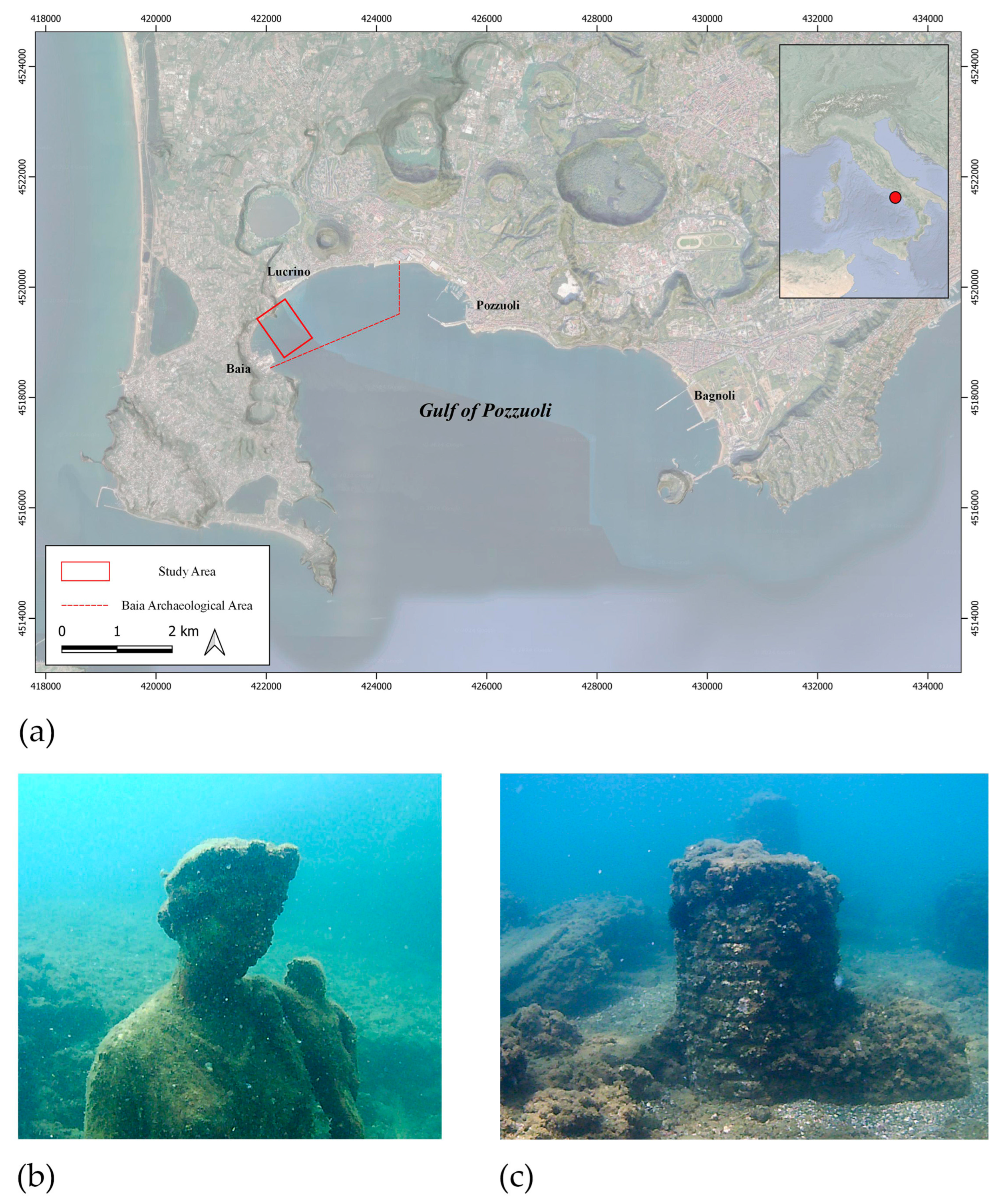
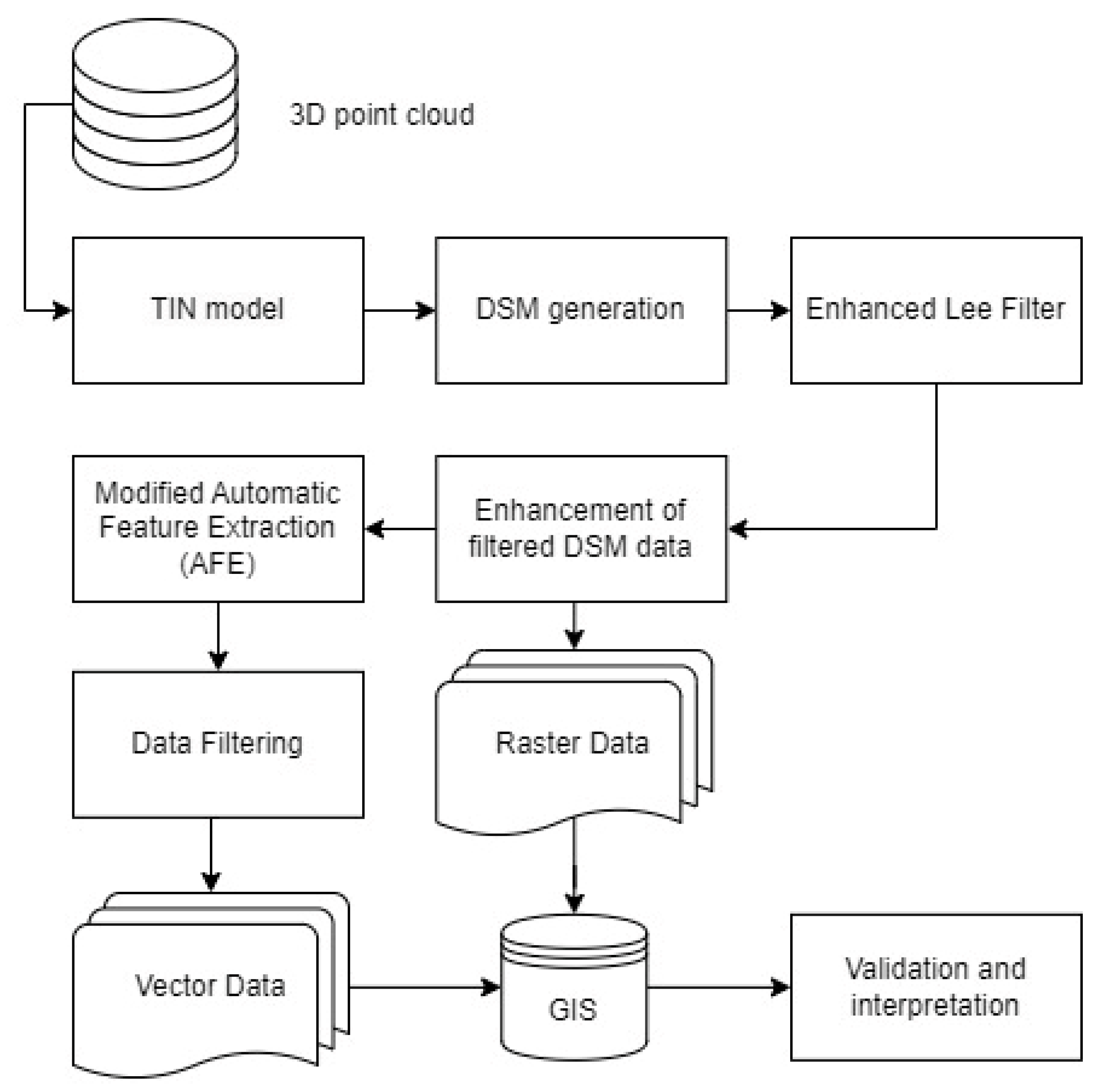
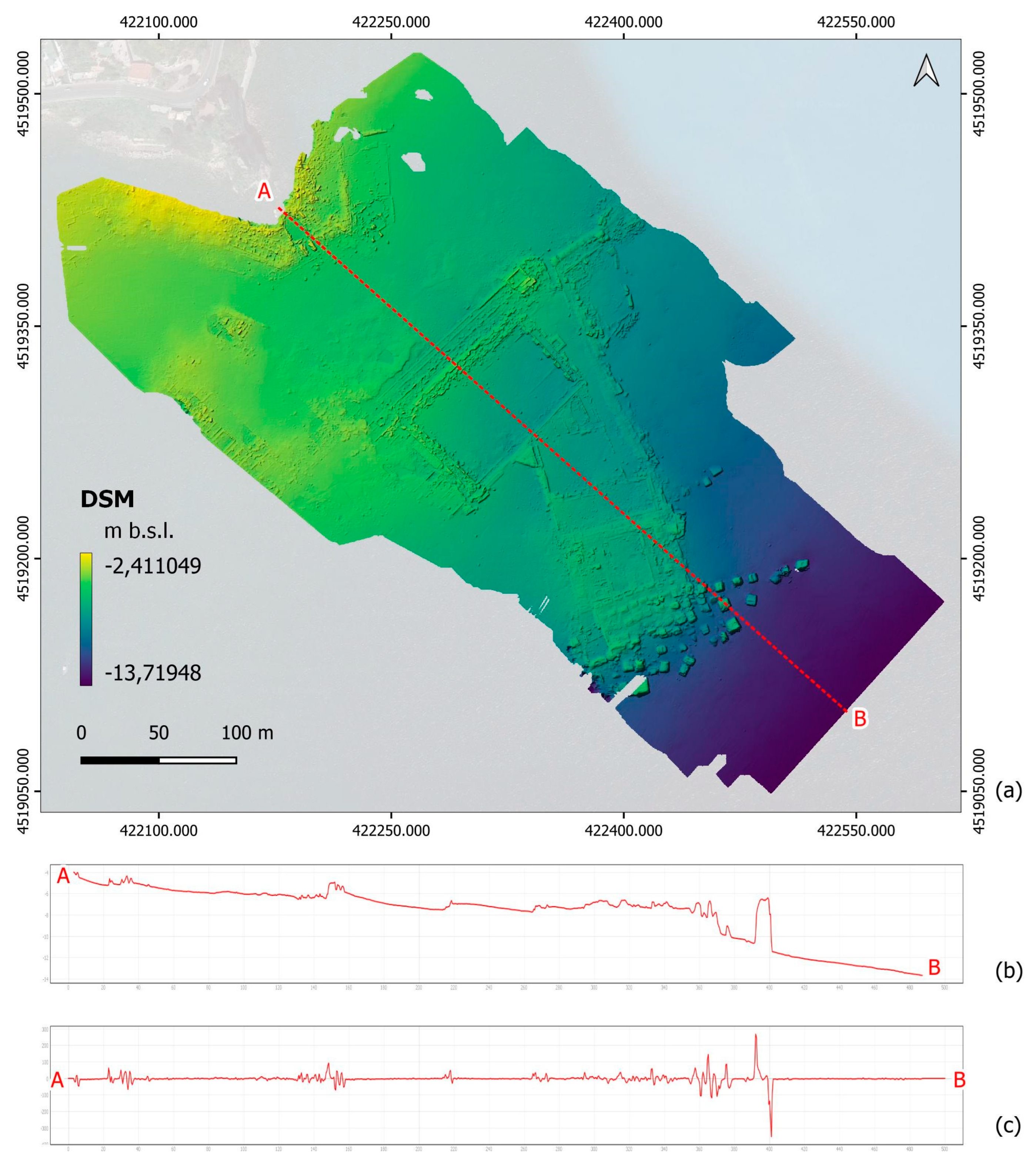
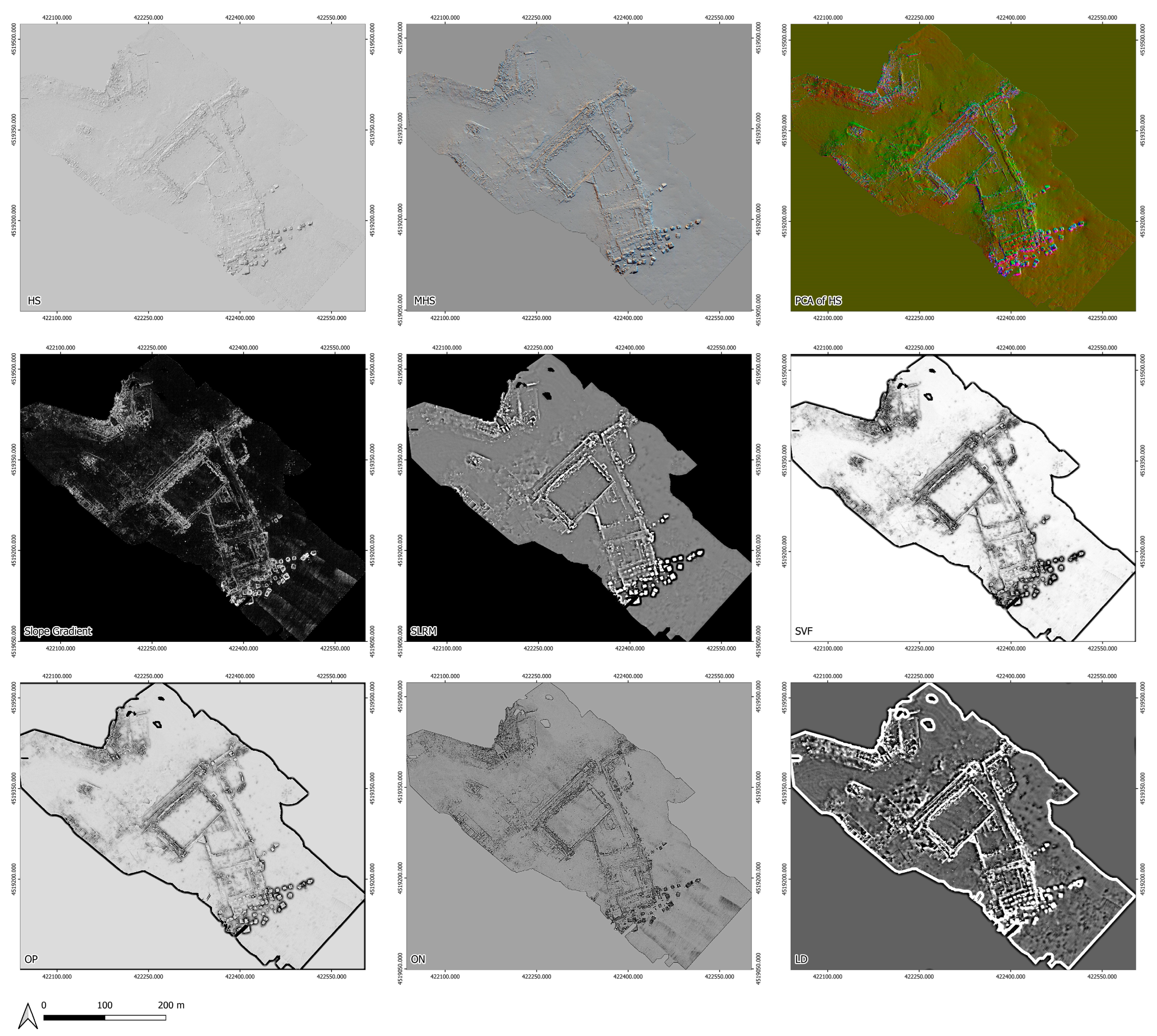
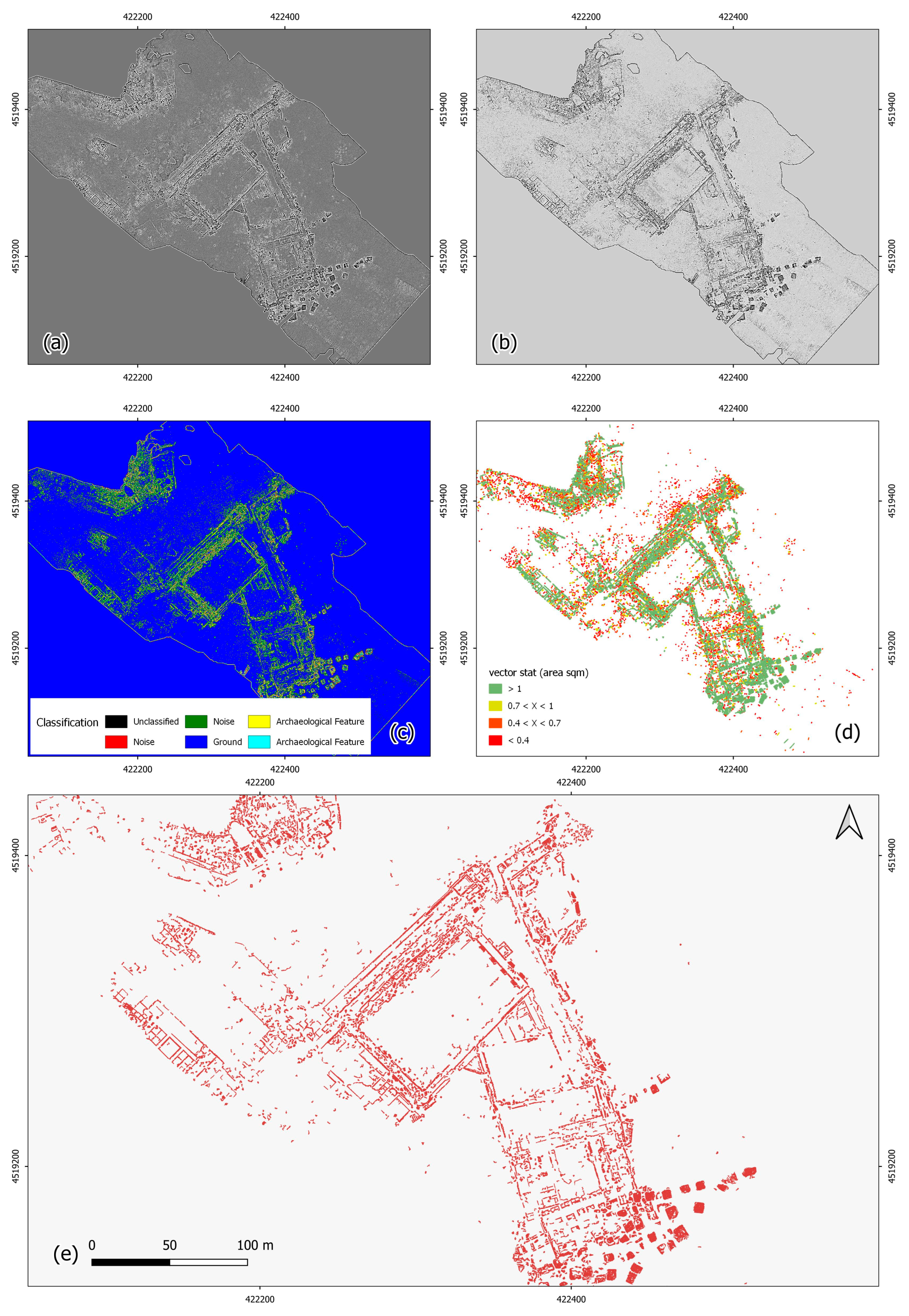
| Visualization Method | Parameters |
|---|---|
| Analytical Hill Shading | Sun azimuth (deg): 315; Sun elevation angle (deg): 35 |
| Hill Shading from Multiple Directions | Number of directions: 16; Sun elevation angle (deg): 35 |
| PCA of Hill Shading | Number of components to save: 3 |
| Slope Gradient | No parameters required |
| Simple Local Relief Model | Radius for trend assessment (pixel): 20 and 40 |
| Sky-View Factor | Number of search directions: 16; search radius (pixel): 20 and 40 |
| Openness Positive | Number of search directions: 16; search radius (pixel): 20 and 40 |
| Openness Negative | Number of search directions: 16; search radius (pixel): 20 and 40 |
| Local Dominance | Minimum radius: 10 and 20; Maximum radius: 20 and 40 |
| CM | |||
|---|---|---|---|
| True Class | |||
| Predicted Class | Positive | Negative | |
| Positive | 273 | 12 | |
| Negative | 28 | 240 | |
| Type | Score |
|---|---|
| KA | 92.76% |
| P | 0.95 |
| R | 0.90 |
| F1-score | 0.92 |
Disclaimer/Publisher’s Note: The statements, opinions and data contained in all publications are solely those of the individual author(s) and contributor(s) and not of MDPI and/or the editor(s). MDPI and/or the editor(s) disclaim responsibility for any injury to people or property resulting from any ideas, methods, instructions or products referred to in the content. |
© 2024 by the authors. Licensee MDPI, Basel, Switzerland. This article is an open access article distributed under the terms and conditions of the Creative Commons Attribution (CC BY) license (https://creativecommons.org/licenses/by/4.0/).
Share and Cite
Abate, N.; Violante, C.; Masini, N. A Semi-Automatic-Based Approach to the Extraction of Underwater Archaeological Features from Ultra-High-Resolution Bathymetric Data: The Case of the Submerged Baia Archaeological Park. Remote Sens. 2024, 16, 1908. https://doi.org/10.3390/rs16111908
Abate N, Violante C, Masini N. A Semi-Automatic-Based Approach to the Extraction of Underwater Archaeological Features from Ultra-High-Resolution Bathymetric Data: The Case of the Submerged Baia Archaeological Park. Remote Sensing. 2024; 16(11):1908. https://doi.org/10.3390/rs16111908
Chicago/Turabian StyleAbate, Nicodemo, Crescenzo Violante, and Nicola Masini. 2024. "A Semi-Automatic-Based Approach to the Extraction of Underwater Archaeological Features from Ultra-High-Resolution Bathymetric Data: The Case of the Submerged Baia Archaeological Park" Remote Sensing 16, no. 11: 1908. https://doi.org/10.3390/rs16111908
APA StyleAbate, N., Violante, C., & Masini, N. (2024). A Semi-Automatic-Based Approach to the Extraction of Underwater Archaeological Features from Ultra-High-Resolution Bathymetric Data: The Case of the Submerged Baia Archaeological Park. Remote Sensing, 16(11), 1908. https://doi.org/10.3390/rs16111908








